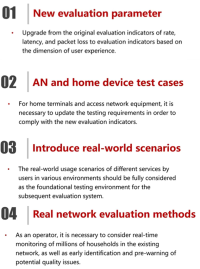 Ding Hai, Fixed Access Network and home Networking Expert at China Unicom highlighted the need for a new broadband quality evaluation system during his presentation. He emphasized that the current focus on Quality of Service (QoS) must shift to Quality of Experience (QoE) to meet the demands of next-generation broadband networks.
Ding Hai, Fixed Access Network and home Networking Expert at China Unicom highlighted the need for a new broadband quality evaluation system during his presentation. He emphasized that the current focus on Quality of Service (QoS) must shift to Quality of Experience (QoE) to meet the demands of next-generation broadband networks.
Future broadband access and home networks promise higher bandwidth, lower latency, and greater stability. More importantly, it will enhance connectivity capabilities and elevate end-to-end service experience, unlocking new business opportunities for network operators. Hai pointed out, however, that existing broadband quality evaluation methods fall short of the requirements of these networks. Traditional metrics like speed, latency, and packet loss are no longer sufficient to address the needs of next-generation smart home applications and evolving user expectations. Despite ongoing network upgrades, operators continue to receive complaints about poor user experience, particularly as demand surges for applications like VR, cloud gaming, and other applications that require low latency.
“In response to technological evolutions, network upgrades, and market competition, service providers,  equipment vendors, and standards organizations across the industry must collaborate on researching and developing a new end-to-end network quality evaluation system”, Hai stated. He outlined four key areas for consideration in this transformation – shifting from a QoS-focused approach that measures network performance via KPIs like speed and latency, to a user-centric model prioritising QoE. This would encompass Customer Experience Management (CEM) and Customer Experience Indicators (CEI) to provide a more accurate reflection of real-world user satisfaction.
equipment vendors, and standards organizations across the industry must collaborate on researching and developing a new end-to-end network quality evaluation system”, Hai stated. He outlined four key areas for consideration in this transformation – shifting from a QoS-focused approach that measures network performance via KPIs like speed and latency, to a user-centric model prioritising QoE. This would encompass Customer Experience Management (CEM) and Customer Experience Indicators (CEI) to provide a more accurate reflection of real-world user satisfaction.
Hai acknowledged the challenges in establishing a standardized evaluation system. Different users have varying expectations depending on the type of service, making it difficult to define a single universal standard. He posed critical questions: Can a standardized end-to-end QoE index, similar to Broadband Forum’s TR-101, be developed despite the diversity of network architectures? How will the system be implemented – will it take the form of a global industry guideline, or evolve into a certification standard, akin to TR-069 or TR-398?
Hai concluded that industry-wide collaboration will be essential to defining a new series of Technical Reports (TRs) that can serve as the benchmark from broadband operators worldwide, ensuring a higher quality of experience for end users.
